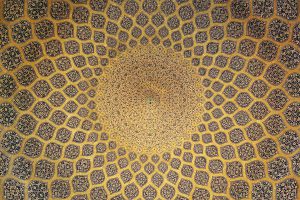Tashbīh and Its Various Types

By Mohammad Nawaz (3rd Year ʿĀlim Student, DarusSalam Seminary)
Throughout history, people have used similes and metaphors to communicate ideas, images, concepts, etc. Being versed in these forms of figurative language helps one understand many literary and religious works, speeches, and even daily conversations. In the science of rhetoric (ar. balāghah), the term tashbīh is used for similes and metaphors. There are different types of tashbīh. Some its types are similes and others are metaphors.
Before learning the various types of tashbīh, one must know its integrals. Tashbīh has four integrals. They are: (1) the Mushabbah; (2) the Mushabbah bihi; (3) the Adāt al-tashbīh; (4) and the Wajh al-shabah.
The mushabbah is the object or entity that is being compared. The mushabbah bihi is the object or entity to which the resemblance is being made. These two are the crux of tashbīh; without them, there is no tashbīh. The third, the adāt al-tashbīh, is the word used to convey the meaning of resemblance between the mushabbah and the mushabbah bihi. This integral can be a noun, a verb, or a preposition. The last component, the wajh al-shabah, is the connection that is shared between the mushabbah and the mushabbah bihi.[1]
An example illustrating these four integrals is found in the statement:
العلم كالنور في الهداية
“Knowledge is like light in terms of guiding.”[2]
In this simile, the mushabbah is the word “knowledge” (ar. ʿilm) as it is being resembled to the mushabbah bihi. The word “light” (ar. nūr) is the mushabbah bihi as it is the thing to which the mushabbah is being resembled. If one of these two integrals were absent, the tashbīh would not exist. The adāt al-tashbīh is the word “like,” which is the preposition, the kāf, translated. Lastly, the wajh al-shabah is the quality of guiding (ar. hidāyah) that can be found in both the mushabbah and the mushabbah bihi.
As mentioned, in a tashbīh the presence of both the mushabbah and the mushabbah bihi is necessary. However, the adāt al-tashbīh and the wajh al-shabah may be omitted at times. In fact, in some situations this is preferable. Omitting them may produce a greater resemblance between the mushabbah and the mushabbah bihi. Therefore, based on the adāt al-tashbīh and the wajh al-shabah’s presence in the texts and their elision, tashbīh is divided into four types. They are:
(1) mursal mufaṣṣal
(2) mursal mujmal
(3) muʾakkad mufaṣṣal
(4) muʾakkad mujmal/balīgh[3]
The first type is mursal mufaṣṣal. A tashbīh that is mursal is one in which the adāt al-tashbīh is mentioned. And the mufaṣṣal is one in which the wajh al-shabah is mentioned.[4] This is the standard form of tashbīh. An example is found in the following verse of poetry:
أنت كالليث في الشجاعة والإقدام
“You are like the lion in terms of bravery and courage.”[5]
In this tashbīh, the adāt al-tashbīh is the word “like” (ar. kāf) and the wajh al-shabah is the quality of bravery (ar. shajāʿah) and courage (ar. iqdām) that is shared between both the addressee and the lion. Since the adāt al-tashbīh and the wajh al-shabah are mentioned, the tashbīh is mursal mufaṣṣal.
The second type is mursal mujmal. When a tashbīh is mujmal, the wajh al-shabah is omitted. Thus, the tashbīh mursal mujmal is a simile in which the adāt al-tashbīh is present but not the wajh al-shabah.[6] Generally, one can deduce the wajh al-shabah based on the context and the mushabbah and the mushabbah bihī. For example, Allah says:
فَتَرَى الْقَوْمَ فِيهَا صَرْعَىٰ كَأَنَّهُمْ أَعْجَازُ نَخْلٍ خَاوِيَةٍ
“Such that you could see the people therein hewn down, as if they were hollowed-out date-palm trunks.”[7]
The tashbīh in this verse is mursal mujmal as the adāt al-tashbīh, the word “as” (ar. kaʾanna), is mentioned while the wajh al-shabah is not. Although the wajh al-shabah is omitted, one can infer what is intended. In this case, the wajh al-shabah is the quality of emptiness and lifelessness.
The third type is tashbīh muʾakkad mufaṣṣal. A tashbīh is said to be muʾakkad when the adāt al-tashbīh is omitted.[8] This tashbīh, in essence, is the opposite of tashbīh mursal mujmal. Additionally, the elision of the adāt al-tashbīh directly connects the mushabbah to the mushabbah bihī. This causes a greater effect and resemblance. For example:
الجوادُ في السرعة برقٌ خاطفٌ
“The horse, in terms of speed, is lightning that snatches one’s sight.”[9]
In this metaphor, the horse is being resembled to lightning. However, there is no adāt al-tashbīh. Instead, it is said that the horse is lightning. This statement, although untrue, is valid for the sake of comparison. In short, this tashbīh is muʾakkad mufaṣṣal because the adāt al-tashbīh is omitted while the wajh al-shabah is present.
The last type of tashbīh, tashbīh muʾakkad mujmal, is a metaphor in which both the adāt al-tashbīh and the wajh al-shabah are omitted. Although this type, in principle, is muʾakkad mujmal, rhetoricians give it a unique name. They call this type balīgh.[10] The tashbīh balīgh is the most eloquent form of tashbīh, oftentimes requiring a good grasp of the language to be understood. For example, the eminent poet, Mutanabbī, once recited the following couplets in praise of the Caliph Sayf al-Dawlah:
أَينَ أَزمَعتَ أَيُّهَذا الهُمامُ
نَحنُ نَبتُ الرُبى وَأَنتَ الغَمامُ
“Where have you determined to go, O brave one?
We are the plants of the highlands while you are the rain cloud.”[11]
In this verse of poetry, Mutanabbī is resembling himself and all those under the caliph’s rule to the plants of the highlands. He is also resembling the caliph to a rain cloud. In both metaphors, the adāt al-tashbīh and the wajh al-shabah are omitted. Therefore, these tashbīhs are balīgh.
As for the wajh al-shabah in the first tashbīh balīgh, it is the quality of helplessness and needing an external life source to survive and thrive. Just as the plants in the highlands need plentiful rain, Mutanabbī is claiming that the people, including himself, need the caliph and his support. And thus, Mutanabbī is objecting to the caliph’s decision to travel.
The wajh al-shabah in the second tashbīh balīgh is the quality of being a source of benefit and being relied on by others. Just like how rain is necessary for plants, the caliph is necessary for the prosperity of the kingdom and its people.
In conclusion, tashbīh is an integral aspect of rhetorical and figurative language. It can be divided into four types based on the presence of the adāt al-tashbīh and the wajh al-shabah or their elision. Understanding these types will help one recognize and comprehend similes and metaphors, not only in Arabic, but in all languages.
Works Cited
ʿAlī al-Jāzim and Muṣṭafā Amīn. al-Balāghat al-Wāḍiḥah. Karāchi: Maktabat al-Bushrā, 2010.
Muḥammad Diyāb, Sulṭān Muḥammad, Muṣṭafā Ṭamūm, and Ḥafnī Nāṣif, Durūs al-Balāghah.
Karāchi: Maktabat al-Madīnah, 2013.
ʿAbd al-ʿAzīz al-ʿAtīq. ʿIlm al-Bayān. Beirūt: Dār al-Nahḍat al-ʿArabiyyah.
[1] ʿAlī al-Jāzim and Muṣṭafā Amīn, al-Balāghat al-Wāḍiḥah, (Karachi: Maktabat al-Bushrā, 2010), 18.
[2] Muḥammad Diyāb, Sulṭān Muḥammad, Muṣṭafā Ṭamūm, and Ḥafnī Nāṣif, Durūs al-Balāghah, (Karachi: Maktabat al-Madīnah, 2013), 144.
[3] al-Jāzim and Amīn, al-Balāghat al-Wāḍiḥah, 24.
[4] Ibid., 24.
[5] Ibid., 17.
[6] Ibid., 24.
[7] Q, 69:7. Ahmad Z. Hammad, The Gracious Quran: A Modern-Phrased Interpretation in English, (Lucent Interpretations, 2008), 1006.
[8] al-Jāzim and Amīn, al-Balāghat al-Wāḍiḥah, 24.
[9] Ibid., 22.
[10] Ibid., 24.
[11] ʿAbd al-ʿAzīz al-ʿAtīq, ʿIlm al-Bayān, (Beirut: Dār al-Nahḍat al-ʿArabiyyah), 80.


